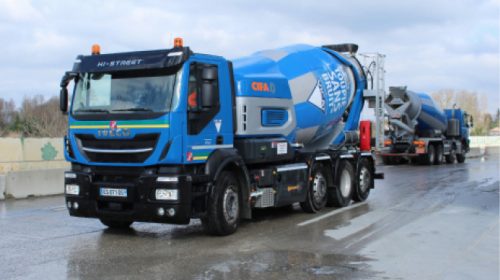The newest addition to the fleet of Béton Vicat, a Lyon, France, sister business of National Cement Co. in North America, is a radical departure from a diesel fuel- and hydraulic fluid-propelled concrete mixer. A production model billed as a “disruptive innovation for the roads of France,” the Oxygène truck runs on a compressed natural gas engine and bears a lithium battery-powered electric mixer drive. Operation throughout the ready mixed loading and delivery cycle is nearly 100 percent carbon dioxide emission-free.
|
|
| Béton Vicat will add up to 20 of the renewable CNG- and lithium battery-powered Oxygène mixers by the end of 2019. PHOTOS: Vicat Group, Paris |
 |
| The inaugural Oxygène is running in Lyon, one of France’s largest cities outside Paris. |
 |
Béton Vicat deployed the Oxygène earlier this year, following late-2017 exhibits and demonstrations in France. The truck is a team effort of the country’s Vicat Group, Paris-based parent of Béton Vicat and National Cement, plus Jacky Perennot, a fleet operator and construction truck builder with an extensive shop footprint across Europe; and, Italy’s Iveco, a heavy-duty truck and engine brand in Europe, plus CIFA, concrete pump manufacturer and mixer truck builder.
The Oxygène places CIFA’s electric motor-driven Energya hybrid mixer drum on an Iveco Trakker cabover chassis, equipped with Iveco compressed natural gas engine, plus three steering axles equal to the classically narrow streets of urban Europe. Lithium batteries powering the Energya are recharged when the engine is engaged or the truck decelerating, the latter attributable to the CIFA Kinetic Energy Recovery System. The batteries can also be charged by conventional power plug in (four hours at 380V).
“By using electric battery energy, concrete can be mixed independently when the truck engine is off, allowing for silent loading and discharging operations,” Vicat Group noted upon the September 2017 Oxygène unveiling. “Setting aside background noise, the Energya series reduces perceived noise by half. These technical characteristics are especially significant in enclosed job sites or working environments, where every noise is amplified and exhaust fumes are a danger to workers’ health.”
BUSINESS IMPERATIVE
The Oxygène responds to European market demands for a) urban-centered, heavy-duty vehicles running on diesel fuel alternatives; and, b) a new generation of concrete mixer trucks operating at lower decibel levels than predecessor models. The truck delivers on both fronts. As a motor fuel, natural gas emits 20 percent less carbon dioxide than gasoline, while the renewable biomethane behind the natural gas fueling the Oxygène is even more ecologically friendly. Derived from organic waste, then purified, renewable natural gas exhibits the same properties of fossil varieties. Both grades reduce greenhouse-gas emissions by 80 percent against gasoline or diesel alternatives. CNG-powered heavy-duty truck engines run at about half the noise level as diesel fuel models. That operating detail, coupled with the near-silent Energya running mode, positions the Oxygène as markedly quieter than conventional concrete mixer trucks.
“Nobody believed in a vehicle of this type,” said Béton Vicat Logistics Manager Jean-Baptiste Pastor at the truck’s dedication in Paris. The producer nevertheless rose to the challenge, he noted, and brought the near-zero CO2 emissions mixer truck to life with the CIFA, Iveco and Jacky Perrenot team.
“Apart from the technological quest, it is the human endeavor that predominates in this kind of operation,” added Jacky Perrenot CEO Philippe Givone. “The project unites as much internally as externally. It serves to change the image of the business and show through concrete actions that we can be innovative and inventive.”
